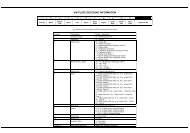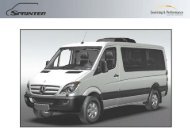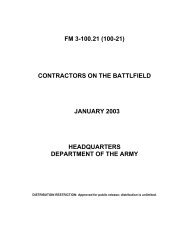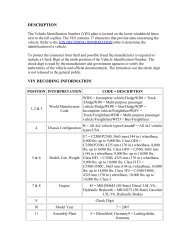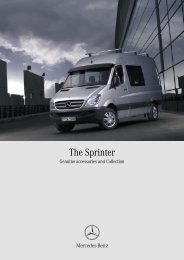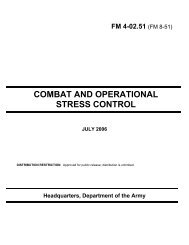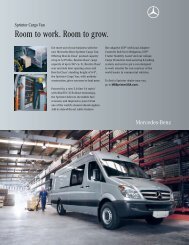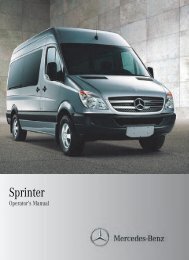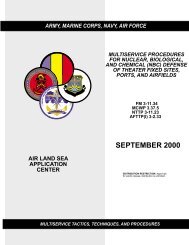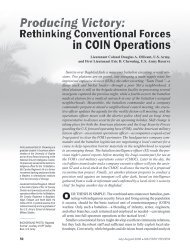WH NCV3 USA/CAN MY 2011 MB, 1, en-US - Mercedes-Benz Sprinter
WH NCV3 USA/CAN MY 2011 MB, 1, en-US - Mercedes-Benz Sprinter
WH NCV3 USA/CAN MY 2011 MB, 1, en-US - Mercedes-Benz Sprinter
You also want an ePaper? Increase the reach of your titles
YUMPU automatically turns print PDFs into web optimized ePapers that Google loves.
8 Description of emission system maint<strong>en</strong>ance jobs<br />
Maint<strong>en</strong>ance Booklet<br />
Emission system maint<strong>en</strong>ance<br />
Emission control system caution -<br />
diesel <strong>en</strong>gines<br />
Your <strong>Sprinter</strong> is equipped with emission<br />
control devices to comply with curr<strong>en</strong>t diesel<br />
exhaust emission regulations in countries<br />
where the vehicle is certified for sale.<br />
Observe our recomm<strong>en</strong>ded maint<strong>en</strong>ance<br />
instructions in order to <strong>en</strong>sure the proper<br />
operating state of your vehicle.<br />
Observe the following:<br />
a) Diesel <strong>en</strong>gines require diesel fuel with<br />
extremely low sulfur cont<strong>en</strong>t for road vehicles<br />
(maximum 15 ppm sulfur), in compliance with<br />
ASTM standard D975. Failure to use ultra low<br />
sulfur highway diesel fuel (ULSD) can severely<br />
damage the vehicle's exhaust gas<br />
aftertreatm<strong>en</strong>t system.<br />
b) We approve the use of B5 (standard ULSD<br />
which may contain up to 5% bio-diesel) for all<br />
BlueEFFICIENCY ® diesel <strong>en</strong>gines.<br />
Diesel fuels which contain a higher proportion<br />
of bio-diesel, e.g. B20, or pure bio-diesel fuel<br />
can severely damage the <strong>en</strong>gine and fuel<br />
system and are not permitted.<br />
Contact your service c<strong>en</strong>ter for further<br />
information. If the B5 biodiesel bl<strong>en</strong>d is not<br />
suffici<strong>en</strong>tly labeled to clearly indicate that it<br />
meets the <strong>US</strong>LD standard, it should not be<br />
used. The New Vehicle Limited Warranty for<br />
new vehicles does not cover damage caused<br />
by the use of fuels not meeting fuel standards<br />
approved by the distributor named on the<br />
inside of the front cover.<br />
c) The prescribed <strong>en</strong>gine maint<strong>en</strong>ance<br />
work must be carried out fully and at the<br />
required intervals.<br />
d) Exhaust gas aftertreatm<strong>en</strong>t system<br />
operation must not be modified in any<br />
way. Alterations are not permissible by law.<br />
Alterations can also damage the catalytic<br />
converter and result in increased fuel<br />
consumption and impaired <strong>en</strong>gine running<br />
conditions.<br />
If the "CHECK ENGINE" indicator lamp lights<br />
up in the instrum<strong>en</strong>t cluster wh<strong>en</strong> the <strong>en</strong>gine<br />
is running, this indicates that there may have<br />
be<strong>en</strong> a malfunction in the <strong>en</strong>gine control<br />
system or in the exhaust gas aftertreatm<strong>en</strong>t<br />
system.<br />
We recomm<strong>en</strong>d that the malfunction is<br />
checked as soon as possible.<br />
BlueEFFICIENCY ® exhaust gas<br />
aftertreatm<strong>en</strong>t using DEF<br />
BlueEFFICIENCY ® exhaust gas<br />
aftertreatm<strong>en</strong>t requires a reducing ag<strong>en</strong>t<br />
(DEF) in order to function properly.<br />
Maintaining the level and condition of the DEF<br />
is part of the regular maint<strong>en</strong>ance service<br />
work.<br />
DEF is a non-flammable, non-toxic, colorless<br />
and odorless, water-soluble liquid.<br />
! Only use DEF according to ISO 22241. Do<br />
not add special additives to DEF or dilute it<br />
with water. This can damage the<br />
BlueEFFICIENCY ® exhaust gas<br />
aftertreatm<strong>en</strong>t.<br />
Description of emission system<br />
maint<strong>en</strong>ance jobs<br />
The composition of exhaust emissions is<br />
influ<strong>en</strong>ced not only by the exhaust gas<br />
aftertreatm<strong>en</strong>t system, but also by various<br />
<strong>en</strong>gine parts and their settings.<br />
Maint<strong>en</strong>ance of the exhaust system must<br />
therefore include these <strong>en</strong>gine parts. Some<br />
maint<strong>en</strong>ance jobs are actually only tests.<br />
They are important, however, because they<br />
allow early detection of discrepancies which<br />
can later lead to increased exhaust<br />
emissions. It is g<strong>en</strong>erally less costly to adjust<br />
deviations of this sort immediately than to<br />
wait until they incur high repair costs. The<br />
maint<strong>en</strong>ance intervals have be<strong>en</strong> determined<br />
so that the vehicle, under normal operating



